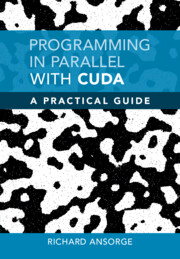Book contents
- Frontmatter
- Dedication
- Contents
- Figures
- Tables
- Examples
- Preface
- 1 Introduction to GPU Kernels and Hardware
- 2 Thinking and Coding in Parallel
- 3 Warps and Cooperative Groups
- 4 Parallel Stencils
- 5 Textures
- 6 Monte Carlo Applications
- 7 Concurrency Using CUDA Streams and Events
- 8 Application to PET Scanners
- 9 Scaling Up
- 10 Tools for Profiling and Debugging
- 11 Tensor Cores
- Appendix A A Brief History of CUDA
- Appendix B Atomic Operations
- Appendix C The NVCC Compiler
- Appendix D AVX and the Intel Compiler
- Appendix E Number Formats
- Appendix F CUDA Documentation and Libraries
- Appendix G The CX Header Files
- Appendix H AI and Python
- Appendix I Topics in C++
- Index
2 - Thinking and Coding in Parallel
Published online by Cambridge University Press: 04 May 2022
- Frontmatter
- Dedication
- Contents
- Figures
- Tables
- Examples
- Preface
- 1 Introduction to GPU Kernels and Hardware
- 2 Thinking and Coding in Parallel
- 3 Warps and Cooperative Groups
- 4 Parallel Stencils
- 5 Textures
- 6 Monte Carlo Applications
- 7 Concurrency Using CUDA Streams and Events
- 8 Application to PET Scanners
- 9 Scaling Up
- 10 Tools for Profiling and Debugging
- 11 Tensor Cores
- Appendix A A Brief History of CUDA
- Appendix B Atomic Operations
- Appendix C The NVCC Compiler
- Appendix D AVX and the Intel Compiler
- Appendix E Number Formats
- Appendix F CUDA Documentation and Libraries
- Appendix G The CX Header Files
- Appendix H AI and Python
- Appendix I Topics in C++
- Index
Summary
Chapter 2 gives a more formal account of the ideas introduced in Chapter 1. We discuss the requirements for writing CUDA kernel code and explain the syntax in detail. We encourage the reader to start thinking in parallel by introducing some key coding ideas including methods for summing a large number of values in parallel for so-called reduction operations. This chapter also introduces GPU shared memory, illustrated with a tiled matrix multiplication example. We demonstrate how the __restrict keyword applied to kernel pointer arguments can speed up your code. In some sense this is our most conventional chapter for a book on CUDA, and the reduction operation is revisited in a number of later chapters to help introduce new CUDA features. However, many of our other examples go well beyond what you can find elsewhere.
- Type
- Chapter
- Information
- Programming in Parallel with CUDAA Practical Guide, pp. 22 - 71Publisher: Cambridge University PressPrint publication year: 2022

